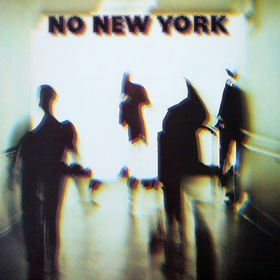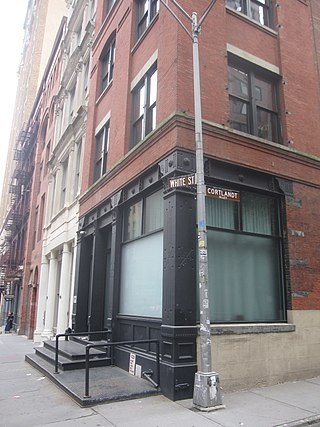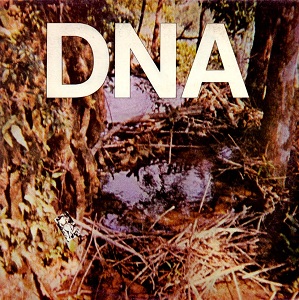Related Research Articles
No wave is a music genre, named for the transient avant-garde music and visual art scene from which it emerged in the late 1970s in downtown New York City.

Mars was an American, New York City-based no wave experimental noise rock band, formed in 1975 when China Burg and artist Nancy Arlen (drums) brought Mark Cunningham (bass) and vocalist Sumner Crane together to talk about music. They were joined briefly by guitarist Rudolph Grey. The band played one live gig under the name China before changing it to Mars. They played a mixture of angular compositions and freeform noise music jams, featuring surrealist lyrics and non-standard drumming. All the members were said to be completely untrained in music before forming the band.

Arthur Morgan "Arto" Lindsay is an American guitarist, singer, record producer and experimental composer. He was a member of the pioneering 1970s no wave group DNA, which featured on the 1978 compilation No New York. In the 1980s, he formed the group Ambitious Lovers. He also performed with The Golden Palominos and The Lounge Lizards.

Ikue Mori, also known as Ikue Ile, is a drummer, electronic musician, composer, and graphic designer. Mori was awarded a "Genius grant" from the MacArthur Foundation in 2022.

James Chance, also known as James White, is an American saxophonist, keyboard player, and singer.

Teenage Jesus and the Jerks were an influential American no wave band, based in New York City, who formed part of the city's no wave movement.

James Chance and the Contortions was a musical group led by saxophonist and vocalist James Chance, formed in 1977. They were a central act of New York City's downtown no wave music scene in the late 1970s, and were featured on the influential compilation No New York (1978).

No New York is a compilation album released in 1978 by record label Antilles under the curation of producer Brian Eno. Although it only contained songs by four different artists, some consider it to be a definitive single album documenting New York City's late-1970s no wave movement.

The Mudd Club was a nightclub located at 77 White Street in the TriBeCa neighborhood of Lower Manhattan in New York City. It operated from 1978 to 1983 as a venue for underground music and counterculture events. It was opened by Steve Maas, Diego Cortez and Anya Phillips.

Gordon Stevenson was an artist, actor, musician and filmmaker who died of AIDS in 1982, one of the East Village art community’s first casualties of the AIDS epidemic.

John Gavanti is a 1980 no wave opera album by members of the bands Mars and DNA. It was written and played by Mark Cunningham, Sumner Crane, China Burg, Ikue Mori and Arto Lindsay. All were prominent members of New York City's short-lived No Wave music scene.
Anya Phillips was an American fashion designer and the co-founder of legendary New York nightclub the Mudd Club along with Steve Maas and Diego Cortez. Phillips had an influence on the fashion, sound and look of the New York-based no wave scene of the late 1970s. She was also the manager and girlfriend of New York-based musician James Chance.
Theoretical Girls were a New York-based no wave band formed by Glenn Branca and Jeff Lohn that existed from 1977 to 1981. Theoretical Girls played only about 20 shows. It released one single, which had some attention in England where it sold a few thousand copies. The band was never signed by a record company, but is well regarded as an early leading no wave group that mixed classical modern ideas of composition with punk rock. This experimental music was mostly supported by the New York art world and minimal art music audience.

Robin Lee Crutchfield is an American artist. He is best known as one of the founding musicians of the former New York No Wave scene. He has performed at such hallowed musical grounds as Tier 3, CBGB's, Max's Kansas City and Artists Space; as well as had his work on display at prestigious venues like MoMA and The Whitney Museum of American Art.
Noise Fest was an influential festival of no wave noise music performances curated by Thurston Moore of Sonic Youth at the New York City art space White Columns in June 1981. Sonic Youth made their first live appearances at this show.
Tier 3 was an influential but short-lived 300-capacity no wave art nightclub in New York. Founded by Hilary Jaeger in 1979, Tier 3 was a major venue in the city's underground music and counterculture post-punk art scene, along with the Mudd Club. Live performances showcased punk rock, no wave, ska, noise music, free jazz, new wave and experimental music. The club was located at 225 West Broadway in the TriBeCa neighborhood of lower Manhattan.

A Taste of DNA is an EP by the no wave band DNA, released in 1981 through American Clavé. It was to be the band's last album to be released before they disbanded the following year.

DNA is a live album by DNA, released in 1993 through Avant Records.
Boris Policeband was a no wave noise music performer who used dissonant violin, police radio transmissions, and voice. Boris Pearlman was a classically trained violist from New York City.

Nancy Arlen was a cast polyester resin sculptor and drummer for the no wave band Mars.
References
- Masters, Marc (2007). No Wave. London: Black Dog Publishing.
- Moore, Thurston; Coley, Byron (2008). Post-Punk. Underground. New York. 1976–1980 . Abrams Image. ISBN 978-0-8109-9543-7.